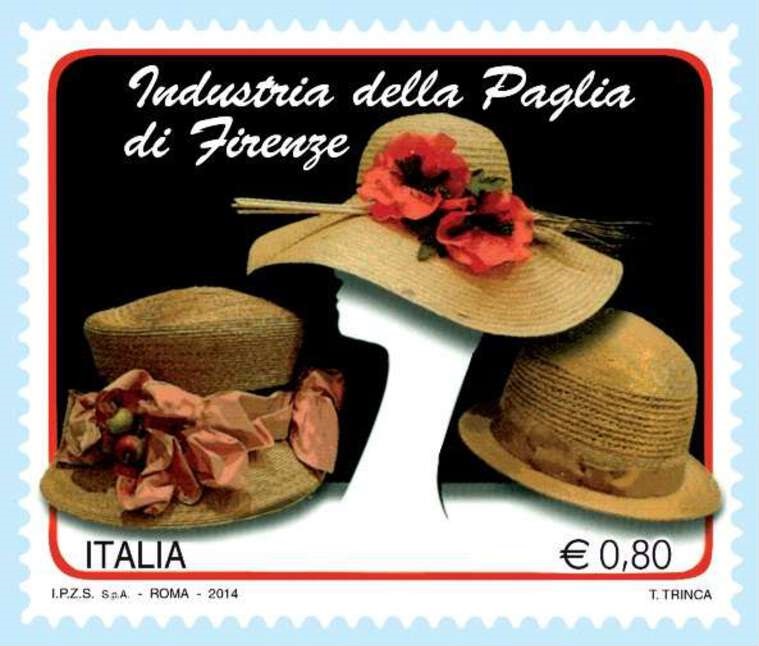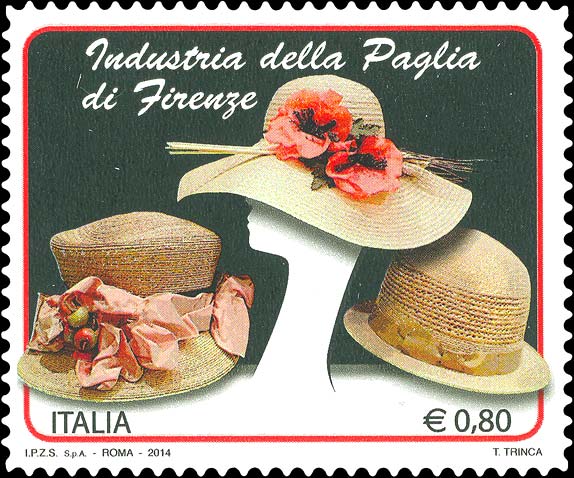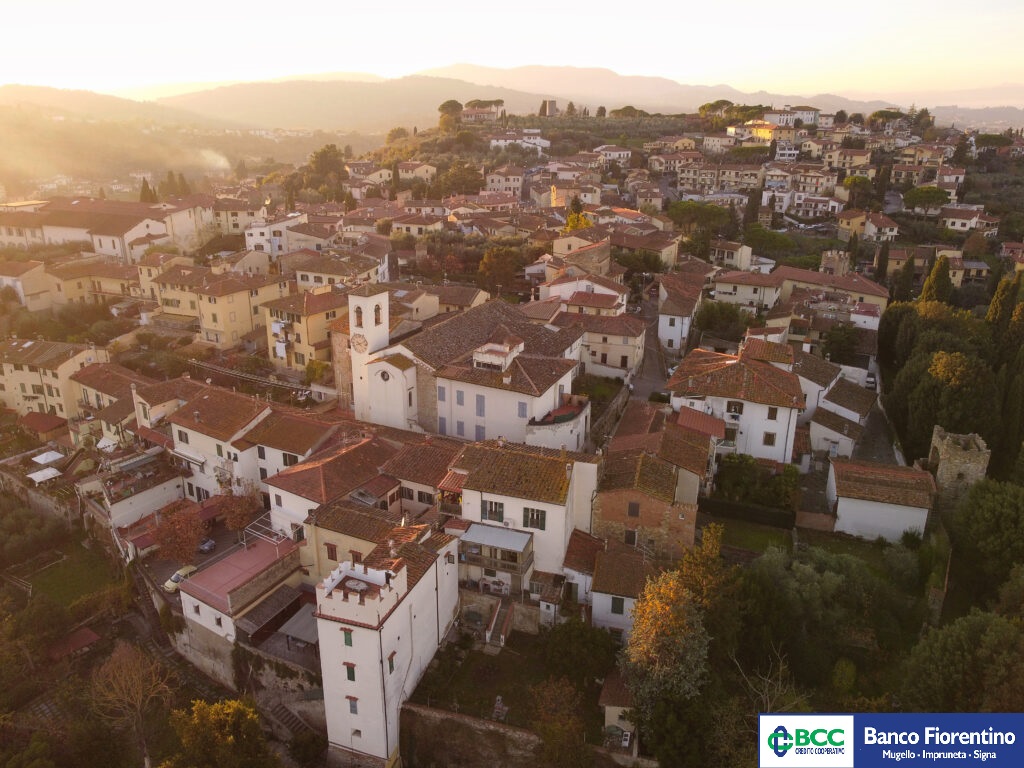
Francobollo Celebrativo “Industria della Paglia di Firenze”
E’ stato presentato il 20 dicembre 2014 presso la Salablù del Centro Culturale Boncompagno da Signa, il Francobollo Celebrativo appartenente alla serie tematica “Le Eccellenze del sistema produttivo ed economico dedicato all’industria della paglia di Firenze”
L’emissione degli ottocentomila esemplari del francobollo da 80 centesimi “Industria della paglia di Firenze” è avvenuta il 29 novembre scorso, su iniziativa del Presidente del Museo della Paglia e dell’Intreccio D. Michelacci a Signa Angelita Benelli che insieme all‘Assessore alla Cultura Giampiero Fossi ha proposto al Ministro dello Sviluppo Economico l’emissione di un francobollo commemorativo in occasione del “Tricentenario della nascita dell’industria della paglia Firenze 1714/1718 – 2014/2018“.
Il buon accoglimento della domanda da parte del Ministero si è concretizzato con l’emissione del francobollo commemorativo dedicato all’industria della paglia di Firenze, considerata tra le eccellenze del sistema produttivo ed economico nazionale.
MINISTERO DELLO SVILUPPO ECONOMICO
DECRETO 20 ottobre 2014
Emissione nell’anno 2014, di un francobollo ordinario appartenente alla serie tematica «le Eccellenze del sistema produttivo ed economico» dedicato all’industria della paglia di Firenze, nel valore di euro 0,80. (14A09036) (GU Serie n.274 del 25-11-2014)
IL DIRETTORE GENERALE
per i servizi di comunicazione elettronica, di radiodiffusione eali del ministero dello sviluppo economico di concerto con
IL CAPO DELLA DIREZIONE VI
del Dipartimento del Tesoro
del Ministero dell’economia e delle finanze
Visto l’art. 32 del testo unico delle disposizioni legislative in materia postale, di bancoposta e di telecomunicazioni, approvato con decreto del Presidente della Repubblica 29 marzo 1973, n. 156;
Visto l’art. 212 del regolamento di esecuzione dei libri I e II del codice postale e delle telecomunicazioni (norme generali e servizi delle corrispondenze e dei pacchi), approvato con decreto del Presidente della Repubblica 29 maggio 1982, n. 655;
Visto l’art. 17 del decreto legislativo 22 luglio 1999, n. 261, di «Attuazione della direttiva 97/67/CE concernente regole comuni per lo sviluppo del mercato interno dei servizi postali comunitari e per il miglioramento della qualità del servizio»;
Visto il decreto legislativo 30 marzo 2001, n. 165, recante «Norme generali sull’ordinamento del lavoro alle dipendenze delle amministrazioni pubbliche»;
Visto il decreto legislativo 30 luglio 1999, n. 300 e successive modificazioni ed integrazioni;
Vista la delibera dell’Autorità per le garanzie nelle comunicazioni n. 728/13/Cons del 19 dicembre 2013 che, all’art. 3, comma 1, prevede che Poste italiane notifichi all’Autorita’ le variazioni di prezzo dei sevizi rientranti nel servizio universale con novanta giorni di anticipo rispetto alla data di entrata in vigore dei prezzi e che tali variazioni non siano soggette ad autorizzazione preventiva da parte dell’Autorita’ che tuttavia puo’ inibire la loro applicazione in caso di violazione della normativa nazionale e regolamentare vigenti;
Vista la comunicazione con la quale, in data 7 agosto 2014, Poste Italiane S.p.A. ha notificato all’Autorita’ per le garanzie nelle comunicazioni la volonta’ di variare i prezzi di alcuni servizi rientranti nel servizio universale con decorrenza 1° dicembre 2014 ed informazione al pubblico in data 1° novembre 2014, fatta salva la facolta’ dell’Autorita’ garante di inibire e/o modificare quanto sopra;
Vista la nota del capo di Gabinetto del Ministero dello sviluppo economico prot. n. 20578 del 5 settembre 2014 recante «misure urgenti per fronteggiare le variazioni di prezzo dei servizi rientranti nel servizio universale ai sensi della delibera dell’Autorita’ per le garanzie nelle comunicazioni n. 728/13/Cons del 19 dicembre 2013»;
Visto il decreto-legge 16 maggio 2008, n. 85, convertito in legge 14 luglio 2008 n. 121 (Gazzetta Ufficiale n. 164 del 15 luglio 2008), recante «Disposizioni urgenti per l’adeguamento delle strutture di Governo in applicazione dell’art. 1, commi 376 e 377, della legge 24 dicembre 2007, n. 244»;
Visto il decreto del Presidente del Consiglio dei ministri 5 dicembre 2013, n. 158 (Gazzetta Ufficiale n. 19 del 24 gennaio 2014), recante Regolamento di organizzazione del Ministero dello sviluppo economico;
Visto il decreto del Ministro del tesoro, del bilancio e della programmazione economica 8 giugno 1999 (Gazzetta Ufficiale n. 152 del 1° luglio 1999), recante «Riassetto organizzativo dei Dipartimenti del Ministero del tesoro, del bilancio e della programmazione economica»;
Visto il decreto del Ministro del tesoro, del bilancio e della programmazione economica 19 dicembre 2000 (Gazzetta Ufficiale n. 133 dell’11 giugno 2001), recante «Modifiche al riassetto organizzativo dei Dipartimenti centrali del Ministero del tesoro, del bilancio e della
programmazione economica»;
Visto il decreto del Ministro dell’economia e delle finanze 25 luglio 2001 (Gazzetta Ufficiale n. 254 del 31 ottobre 2001), recante «Modificazioni ed integrazioni della struttura e delle competenze dei Dipartimenti centrali del Ministero del tesoro, del bilancio e della programmazione economica»;
Visto il decreto interministeriale 23 gennaio 2014, con il quale e’ stata autorizzata, fra l’altro, l’emissione, a partire dal 2014, di una serie di francobolli da realizzare nel corso di più anni, avente come tematica «le Eccellenze del sistema produttivo ed economico»;
Riconosciuta l’opportunità di emettere, nell’anno 2014, un francobollo ordinario appartenente alla suddetta serie dedicato all’industria della paglia di Firenze;
Visto il parere della Commissione per lo studio e l’elaborazione delle carte valori postali espresso in data 11 settembre 2014;
Vista la scheda tecnica dell’Istituto Poligrafico e Zecca dello Stato S.p.A. prot. n. 49636 del 7 ottobre 2014;
Decreta:
E’ emesso, nell’anno 2014, un francobollo ordinario appartenente alla serie tematica «le Eccellenze del sistema produttivo ed economico» dedicato all’industria della paglia di Firenze, nel valore di € 0,80.
Il francobollo e’ stampato dall’Istituto Poligrafico e Zecca dello Stato S.p.A., in rotocalcografia, su carta bianca, patinata neutra, autoadesiva, non fluorescente; grammatura: 90 g/mq; supporto: carta bianca, autoadesiva Kraft monosiliconata da 80 g/mq; adesivo: tipo acrilico ad acqua, distribuito in quantita’ di 20 g/mq (secco);
formato carta: mm 48 × 40; formato stampa: mm 44 × 36; formato tracciatura: mm 54 × 47; dentellatura: 11 effettuata con fustellatura; colori:cinque; tiratura: ottocentomila esemplari;
bozzettista: Tiziana Trinca. Foglio: ventotto esemplari, valore «€ 22,40».
La vignetta raffigura tre diversi modelli di cappelli di paglia di Firenze esposti al Museo della Paglia e dell’Intreccio «Domenico Michelacci» di Signa. Completa il francobollo la leggenda «Industria della paglia», la scritta «Italia» e il valore «€ 0,80».
Il presente decreto e’ pubblicato nella Gazzetta Ufficiale della Repubblica italiana.
Roma, 20 ottobre 2014
Il direttore generale per i servizi di comunicazione elettronica, di radiodiffusione e postali del Ministero dello sviluppo economico Lanzara
Il Capo della direzione VI del Dipartimento del Tesoro
del Ministero dell’economia e delle finanze Prosperi
L’arte dell’intreccio ha origini antiche e le memorie figurative di oggetti in paglia di ogni tipo, in particolare copricapo, sono innumerevoli.
La commercializzazione della paglia nella provincia di Firenze è documentata già nel 1341, mentre è del 1574 l’attestazione dei cappellai quali appartenenti ad una specifica categoria produttiva.
Nel XVII secolo i navicellai di Ponte a Signa che trasportavano sull’Arno le merci tra Pisa e Firenze indossavano cappelli di paglia intrecciata. Si doveva trattare della comune paglia di grano, ottenuta dopo la battitura, rozza e con qualche imperfezione, ma nobilitata dall’accuratezza e dall’ingegnosità della lavorazione.
Fino agli inizi del XVIII secolo, infatti, non si era trovato materiale più idoneo ad essere intrecciato e con caratteristiche qualitative migliori del grano gentile rosso che “ha fruttato” e cioè che ha già prodotto il seme.
Domenico Michelacci, trasferitosi a Signa dalla Romagna nel 1714, dopo quattro anni di prove sperimentali riuscì a coltivare su queste colline un tipo di grano selezionato che, grazie anche alle caratteristiche dei terreni proprie delle zone tra Signa e Lastra a Signa e attraverso un rivoluzionario sistema di semina e raccolta da lui messo a punto per la prima volta, riuscì a produrre una paglia estremamente fine e lucente, adatta all’intreccio, impiantando anche un laboratorio per la confezione di cappelli per lo più destinati ad essere venduti all’estero.
Quindi possiamo dire che il 1714 è l’anno che ha dato il via alla nascita di un’industria tuttora fiorente e che rappresenta il primo prodotto esportato in tutto il mondo, il precursore del made in Italy. I cappelli di paglia prodotti nell’area fiorentina venivano denominati già nel 1851 Chapeaux de paille d’Italy, ad identificare il nostro Paese ancor prima della sua costituzione come stato unitario.
La storia del cappello di paglia realizzato nell’area fiorentina, cominciata 300 anni fa, non è mai terminata. Nella Piana sono infatti ancora presenti ed attivi importanti industrie e laboratori artigianali di elevata qualità che producono manufatti prestigiosi destinati ad alimentare l’industria del prêt à porter e dell’Alta moda.
Celebratory stamp “Straw Industry of Florence”
On 20 December 2014 at the Salablù of the Boncompagno da Signa Cultural Center, the Celebratory Stamp belonging to the thematic series “The Excellencies of the productive and economic system dedicated to the straw industry of Florence” was presented
The issue of the 800,000 copies of the 80 cents stamp “Industria della straw di Firenze” took place last November 29, on the initiative of the President of the Museo della Paglia e dell’Intreccio D. Michelacci a Signa Angelita Benelli who, together with the Councilor for Culture Giampiero Fossi proposed to the Minister of Economic Development the issue of a commemorative stamp on the occasion of the “Tricentenary of the birth of the Florence straw industry 1714/1718 – 2014/2018”.
The good reception of the request by the Ministry materialized with the issue of the commemorative stamp dedicated to the straw industry of Florence, considered among the excellences of the national productive and economic system.

The art of weaving has ancient origins and the figurative memories of straw objects of all kinds, in particular headgear, are innumerable.
The commercialization of straw in the province of Florence is documented as early as 1341, while the attestation of the hatters as belonging to a specific production category dates back to 1574.
In the 17th century the boatmen of Ponte a Signa who transported goods on the Arno between Pisa and Florence wore woven straw hats. It must have been common wheat straw, obtained after threshing, rough and with some imperfections, but ennobled by the accuracy and ingenuity of the workmanship.
Until the beginning of the eighteenth century, in fact, no material was found that was more suitable for braiding and with better quality characteristics than the red gentle wheat that “has fruited”, i.e. that has already produced the seed.
Domenico Michelacci, who moved to Signa from Romagna in 1714, after four years of experimental trials managed to cultivate a selected type of wheat on these hills which, thanks also to the characteristics of the land typical of the areas between Signa and Lastra a Signa and through a revolutionary system of sowing and harvesting developed by him for the first time, he managed to produce an extremely fine and shiny straw, suitable for weaving, also setting up a laboratory for the manufacture of hats mostly intended to be sold abroad.
So we can say that 1714 is the year that gave way to the birth of an industry that is still thriving and that represents the first product exported all over the world, the forerunner of Made in Italy. The straw hats produced in the Florentine area were already called Chapeaux de paille d’Italy in 1851, to identify our country even before its constitution as a unitary state.
The story of the straw hat made in the Florentine area, which began 300 years ago, has never ended. In fact, important high quality industries and artisan workshops are still present and active in the Piana, producing prestigious products intended to feed the prêt à porter and haute couture industry.
